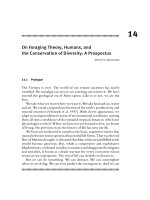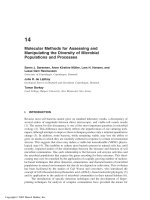Group counseling strategies and skills chapter 14
Bạn đang xem bản rút gọn của tài liệu. Xem và tải ngay bản đầy đủ của tài liệu tại đây (109.3 KB, 15 trang )
Copyright © 2012 Brooks/Cole, a division of Cengage Learning, Inc.
Counseling and Therapy in
Groups
©2016. Cengage Learning. All rights reserved.
Chapter 14
Outcome Goals--goals related to changes
in individual members
Copyright © 2012 Brooks/Cole, a division of Cengage Learning, Inc.
Process Goals--goals related to group
dynamics
©2016. Cengage Learning. All rights reserved.
Goals of Therapy Groups
Screening Members
– referrals from other counselors
– written screening
-- personal interviews
Scheduling group meetings
Copyright © 2012 Brooks/Cole, a division of Cengage Learning, Inc.
Determining Group Size
©2016. Cengage Learning. All rights reserved.
Parameters in Setting up
Therapy Groups
Copyright © 2012 Brooks/Cole, a division of Cengage Learning, Inc.
Knowing the subject or topic
Providing the right atmosphere
Directing the focus
Being aware of individual members
Watching the clock
Apportioning “air time”
©2016. Cengage Learning. All rights reserved.
The Leader’s Role and
Responsibilities
Obtaining a Contract
Using Theory
Copyright © 2012 Brooks/Cole, a division of Cengage Learning, Inc.
Getting, Holding, and Deepening the
Focus
©2016. Cengage Learning. All rights reserved.
The Process of Therapy in a
Group
– Members ask questions
– Members guess what the problem is
– Members role-play with the working member
Use of the Therapeutic Round
– In-depth stationary round
– In-depth movement round
Spinning off
Copyright © 2012 Brooks/Cole, a division of Cengage Learning, Inc.
Techniques for Engaging Members
©2016. Cengage Learning. All rights reserved.
Techniques for Conducting
Therapy in Groups
Too often, leaders just conduct individual
counseling and do not take advantage of
all the possible ways to involve the
members.
Copyright © 2012 Brooks/Cole, a division of Cengage Learning, Inc.
When working with one member, involve
the others.
©2016. Cengage Learning. All rights reserved.
Involve the Members
Copyright © 2012 Brooks/Cole, a division of Cengage Learning, Inc.
Identify common issues
Work briefly with one member while
second member listens
Working members participate in an indepth round or sentence completion
Other members dispute or give
feedback
©2016. Cengage Learning. All rights reserved.
Techniques for Helping More Than
One Member at the Same Time
Copyright © 2012 Brooks/Cole, a division of Cengage Learning, Inc.
Generating topics relevant to a particular
member
Working with a member while aware other
members share the issue and listen
Use of metaphors, analogies, stories
Having members tell of their success with
a problem
©2016. Cengage Learning. All rights reserved.
Technique for Working with
Individuals Indirectly
Copyright © 2012 Brooks/Cole, a division of Cengage Learning, Inc.
The shy member
The dominating member
The rambling member
The angry member
Using member feedback effectively
©2016. Cengage Learning. All rights reserved.
Therapy that Focuses on
Process
Copyright © 2012 Brooks/Cole, a division of Cengage Learning, Inc.
Depends on the leader’s depth of
knowledge of the issue and theories
Depends on the leader’s level of skill
Depends on the leader’s own
psychological health
Depends on group’s capacity to support
working member
Depends on commitment of members to
change
©2016. Cengage Learning. All rights reserved.
How Intense Should Therapy Be
WARNING:
Do not “unzip” (make vulnerable) members
unless you know how to zip them back up!
Intense group therapy requires that you
have good individual counseling skills.
Copyright © 2012 Brooks/Cole, a division of Cengage Learning, Inc.
(CONTINUED)
©2016. Cengage Learning. All rights reserved.
How Intense Should Therapy Be
Copyright © 2012 Brooks/Cole, a division of Cengage Learning, Inc.
Ask if the member wants to work on an
issue
Check with members to see if it is okay to
deviate from the group’s purpose
Limit time devoted to the working member
so as to return to the main purpose
Check with member about follow-up
therapy
©2016. Cengage Learning. All rights reserved.
Providing Therapy in a NonTherapy Group
– Get members to ask questions
– Ask members for feedback
– Ask members if they can relate to the
problem
Copyright © 2012 Brooks/Cole, a division of Cengage Learning, Inc.
Attempting to conduct therapy
without a contract or agreement
Not involving other members—just
doing one-on-one counseling while
others watch. Ways to prevent this
is to:
©2016. Cengage Learning. All rights reserved.
Common Mistakes Leading
Therapy Groups
Spending too much time on one person
Spending too little time on one person
Focusing on an irrelevant topic
Letting members rescue each other
Letting session focus on advice-giving
Leader’s ignorance of the issue, such as
addictions, eating disorders, etc.
Copyright © 2012 Brooks/Cole, a division of Cengage Learning, Inc.
continued
©2016. Cengage Learning. All rights reserved.
Common Mistakes Leading
Therapy Groups









